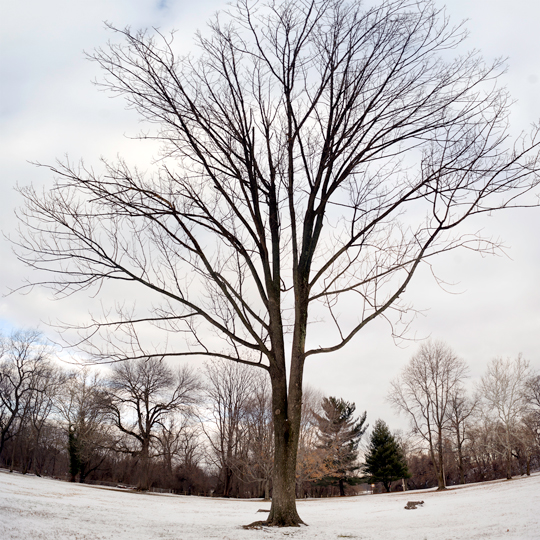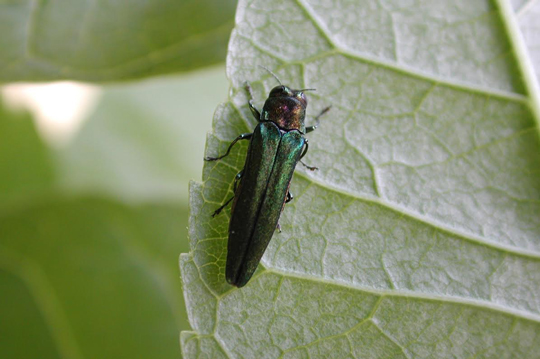 Emerald ash borer beetles target ash trees, like this one at Fairmount Park’s Smith Playground. | Photo by Christian Hunold
Emerald ash borer beetles target ash trees, like this one at Fairmount Park’s Smith Playground. | Photo by Christian Hunold
Tiny green beetles are coming to kill our ash trees
You might expect something as scary as the emerald ash borer to be much larger than it is. The shiny green beetles from East Asia top out at about a centimeter, but they’re enough to bring down an 80-foot ash tree as their populations explode.
“Once they show up, the trees in an area just start to crash really rapidly because they get so overwhelmed,” says Curtis Helm, Project Manager in Philadelphia Parks and Recreation’s Urban Forestry and Ecosystem Management unit.
It’s an old story by now: an exotic pest makes it into the United States, far from its natural predators, and proceeds to wipe out a defenseless native tree species. The emerald ash borer was first spotted in Michigan in 2002, and since then has been jumping outwards like embers from a wildfire, killing off ash trees throughout the Midwest. We have helped them along, transporting them in lumber and firewood cut from infested trees.
Ninety-nine percent of ash trees die within eight years after the emerald ash borer lands in the area. As of 2014, the beetles were in 54 of Pennsylvania’s counties. They haven’t been spotted in Philadelphia yet, but in 2012 they were found in Warrington in Bucks County, only 20 miles away, and in Central New Jersey in 2014.
 The shiny green emerald ash borer beetles from East Asia top out at about a centimeter, but they’re enough to bring down an 80-foot ash tree. | Photo courtesy courtesy Houping Liu: Pa. department of conservation and natural resources
The shiny green emerald ash borer beetles from East Asia top out at about a centimeter, but they’re enough to bring down an 80-foot ash tree. | Photo courtesy courtesy Houping Liu: Pa. department of conservation and natural resources
Insecticide injections every two years can save ash trees, but there are a lot of trees. A U.S. Forest Survey estimated that there are about 200,000 ash trees in Philadelphia, and at $200 per treatment, there is no way the city can afford to treat that many trees.
Ash trees are valuable community and environmental assets when they’re alive, but a dead tree near lots of people is a serious hazard. According to Helms, in 2013 a team of interns did a tree inventory in 2013 and identified roughly 7,500 trees over six inches in diameter (some of these were other unhealthy specimens of other species) within 100 feet of a road, building or anything else vulnerable to a tree fall. Contractors are now in the process of removing the most dangerous of these, safely taking them down before the emerald ash borers do it for them.
Resistance might not be entirely futile. The USDA is testing biological controls, including lethal parasitic insects—parasitoids—that kill emerald ash borers in their native territory. “There’s some hope these parasitoids will eventually maybe over time balance out this vast invasion of emerald ash borers,” Helm says.
As our trees wait for a cure, the city will work to treat a few of them. “We do have about 1,000 trees we’ve put on a treatment list,” Helm says. Treatment will be saved for particularly prominent and picturesque trees, along with some stands to be maintained as a local population reservoir for the future, when we might have a better way to fight back.
Of course, this is not only a problem for our parks. Arborist Shawn Lawson recommended getting to know the ash trees on your property and keeping an eye out for early signs of infestation, such as branches dying back. While it might be prohibitively expensive to treat a lot of trees, a few might be worth it: “If it’s a beautiful tree in the front lawn, I say treat it,” he says.


